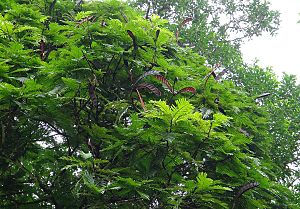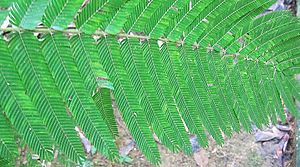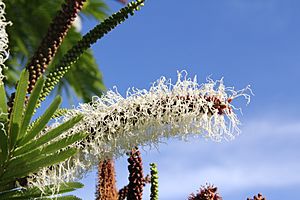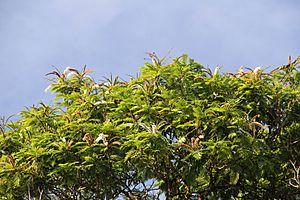Pentaclethra macroloba facts for kids
Quick facts for kids Pentaclethra macroloba |
|
|---|---|
 |
|
| Pentaclethra macroloba tree in Costa Rica | |
| Conservation status | |
| Scientific classification | |
| Genus: |
Pentaclethra
|
| Species: |
macroloba
|
| Synonyms | |
|
Acacia macroloba Willd. |
|
The Pentaclethra macroloba is a big tree found in the wet, tropical parts of Central and South America. It's a type of legume, like peas or beans. This tree has huge, feathery leaves. It often grows in areas that flood, and its seeds can float, helping them spread to new places when the water goes down.
The wood from this tree is very hard. It's used for making furniture and for building. Oil from its large seeds is also used in cosmetics. In some parts of the Amazon rainforest, people use the bark as a traditional medicine for snakebites. Even though the seeds are a bit toxic, some animals like squirrels, parrots, and macaws eat them.
Contents
About the Name and Local Names
The name Pentaclethra comes from Ancient Greek words. Penta means 'five', and cleithro means 'bolt'. This name refers to the five petals and sepals (leaf-like parts) of its flowers that are joined at their base.
This tree has many different names depending on where you are. In the Amazon region of Brazil, it's called pracaxi. In the Arawak language, it's known as koroballi, and in Sranantongo, it's kroebara. In Spanish, people call it gavilán or quebracho.
What the Tree Looks Like
Pentaclethra macroloba trees can be different sizes. In Costa Rica, they grow very tall, reaching up to 30 to 40 meters (about 100 to 130 feet). Their trunks can be as wide as 130 centimeters (about 51 inches). In other places like Brazil, they might be smaller, around 14 meters (46 feet) tall.
The top part of the tree, called the crown, is thick and wide. Young branches are reddish-brown and have soft hairs. They do not have any thorns.
Leaves
The leaves are large and made up of many smaller leaflets, like a feather. They grow in a spiral pattern on the branches. Each leaf can be up to 30 centimeters (12 inches) long. They have many pairs of smaller leaflets, which are leathery and have tiny hairs. Unlike some other similar plants, Pentaclethra leaves do not have special nectar glands.
Flowers
The flowers grow in long spikes, usually about 20 centimeters (8 inches) long. Each spike can have around 320 flowers. The flowers are small, about 2 centimeters (0.8 inches) long, and have a nice scent. They have five petals and ten stamens (the male parts). They also have five long, white, stringy parts called staminodes. These staminodes are very noticeable and help attract pollinators.
Fruit, Seeds, and Seedlings
Even though the tree produces many flowers, only a few turn into fruit. The fruit is a long, flat pod, like a giant bean pod. It can be up to 45 centimeters (18 inches) long. When fresh, it's green, and when dry, it turns dark brownish-grey. The pod is woody and opens suddenly when it dries, twisting to release the seeds. It usually holds three to eight large, flat seeds.
The seeds are dark brown and can be up to 6 centimeters (2.4 inches) long. They are shaped like a lens, spoon, or oval. When a seed starts to grow, it opens up green leaves called cotyledons above the soil. These cotyledons store energy for the young plant as it grows.
How to Identify This Tree
You can recognize this tree by a few key features:
- It has no thorns.
- Its leaves are bipinnate (feather-like) and don't have nectar glands.
- Its flowers grow in large spikes with noticeable white staminodes.
- Its fruit pods are shaped like a machete and stand upright above the branches. They open with a sudden, elastic snap.
- Its large seeds are usually lens-shaped or spoon-shaped.
Where the Tree Grows
This tree grows in different parts of Central and South America. One group of these trees is found in the lowlands of northeast Venezuela and the Guianas, including Trinidad and Tobago. Another group is in western Colombia and eastern Panama. A third group lives in western Panama, Costa Rica, and Nicaragua.
In Costa Rica and Nicaragua, it mostly grows along the eastern coasts. In eastern Panama, it's a very common tree in some wet, swampy forests near the Atlantic coast. In Colombia, it's found along the Pacific coast. It's also common in northern Brazil, in states like Acre and Amazonas.
Ecology and Habitat
Pentaclethra macroloba grows in lowland forests, from sea level up to 600 meters (about 2,000 feet) high in Costa Rica. It loves humid, temporarily flooded rainforests. In the Amazon River estuary in Brazil, it's so common that it forms huge areas where it's almost the only tree species. These trees are used to daily tides.
The trees often flower at the same time during the dry season. In Costa Rica, flowering starts in March. The white staminodes are what attract pollinators like wasps, bees, and ants. The fruit pods appear during the dry season and ripen in the rainy season. This tree stays green all year, even when there are floods.
Seed Dispersal and Life Cycle
This tree uses at least three ways to spread its seeds:
- Mechanical dispersal: When the dry pods split open, they pop and fling the seeds up to 10 meters (33 feet) away from the parent tree. This often happens during the rainy season when rivers overflow.
- Water dispersal: The seeds can float! They develop air pockets when submerged. This means floods and tides can carry them long distances. When the water goes down, the floating seeds get stuck behind fallen branches or roots, often in large groups, helping new trees grow far from the original tree.
- Animal dispersal: As you'll read below, some animals also help spread the seeds.
Like many legumes, P. macroloba helps add nitrogen to the soil. It does this by working with tiny bacteria called Rhizobium, which live in special bumps on the tree's roots. In swampy areas, these roots and their nitrogen-fixing bumps can even grow above ground!
Seed Predation
The seeds of Pentaclethra macroloba are quite poisonous. They contain toxic chemicals that protect them. However, some animals have learned to eat them. For example, the spiny pocket mouse, which lives in these forests, usually avoids the seeds because they are deadly if eaten too much.
A type of moth called Carmenta surinamensis lays its eggs in the seeds. The moth larvae (caterpillars) then eat the seeds from the inside. This can reduce how well the seeds grow, but it doesn't always kill them.
Interestingly, grey squirrels and white-crowned parrots also eat the seeds while they are still inside the pods on the tree. They make a hole in the pod to get to the seeds. They usually only take a few seeds from each pod. Even large Great green macaws have been seen eating these seeds.
Capuchin monkeys have a strange habit called 'anointing'. They rub their bodies with certain objects. In Trinidad, a group of white-fronted capuchins uses the pods of P. macroloba for this. They break open a pod and rub themselves with the inside part. After doing this, they sometimes eat one or more of the seeds. Scientists think the monkeys might be using the seedpods as a kind of medicine or a way to protect themselves.
Uses of the Tree
Timber
The wood of the Pentaclethra macroloba tree is valuable. The outer part of the wood is whitish and dries to a pink color. The inner part, called the heartwood, is reddish-brown. This strong wood is used to make furniture, cabinets, and for general building. It's often sold as 'gavilán' wood.
Other Uses
Pracaxi oil is made from the seeds of P. macroloba. This oil is rich in special acids and is used in 'green' cosmetics as a natural hair conditioner. Both the bark and the seed oil contain a chemical called paucine, which can slow down growth.
In the Guianas, the poisonous bark has been used as a fish poison.
Traditional Medicine: Local people in Brazil and native groups use this plant for traditional medicine. They believe it can help with snakebites, ulcers, and insect bites. For snakebites, they crush the dried bark and put it on the bite. Scientists have studied extracts from the bark and found that they can help reduce bleeding caused by snake venom. This suggests that the plant has some protective effects, possibly by blocking certain chemicals in the venom. Researchers have even found specific compounds in the bark, called macrolobin-A and B, that might be useful in future medicines for snakebites.
Conservation Status
Pentaclethra macroloba is a common tree in the areas where it grows, especially in the Guianas and Central America. It is not currently considered endangered.
Images for kids
See also
 In Spanish: Dormilón para niños
In Spanish: Dormilón para niños








